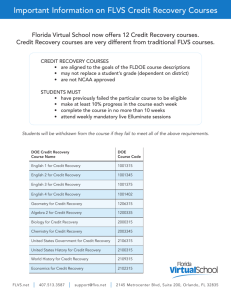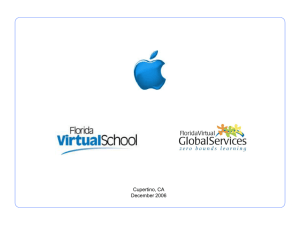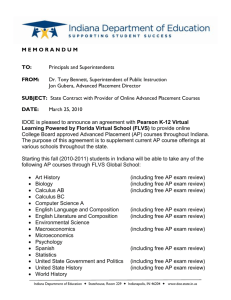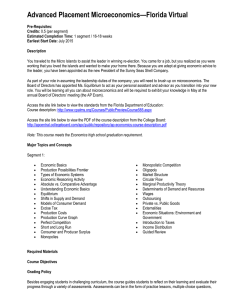NNO SIGHT FLorida VirtuaL SchooL Building the first statewide,
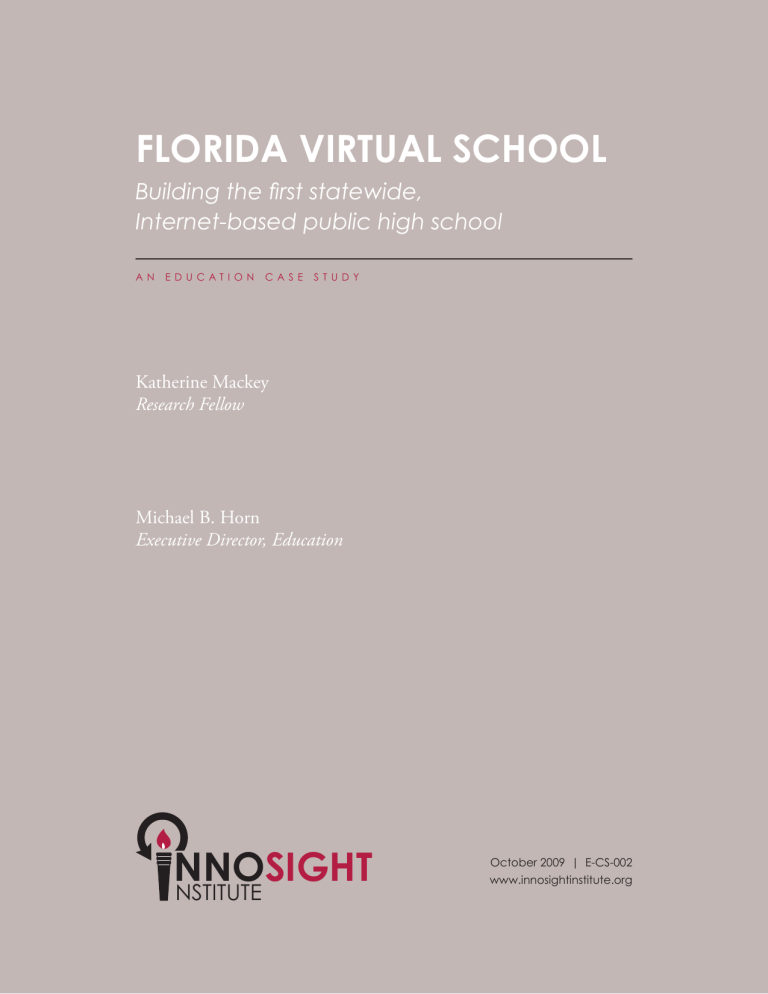
FLorida VirtuaL SchooL
Building the first statewide,
Internet-based public high school
A n E d u C A t i O n C A S E S t u d Y
Katherine Mackey
Research Fellow
Michael B. Horn
Executive Director, Education
NNO
SIGHT
NSTITUTE
October 2009 | E-CS-002 www.innosightinstitute.org
Copyright © 2009 by Innosight Institute, Inc.
All rights reserved.
Innosight Institute, founded in May 2007, is a 501(c)(3) not-for-profit think tank whose mission is to apply Harvard Business School Professor Clayton Christensen’s theories of disruptive innovation to develop and promote solutions to the most vexing problems in the social sector.
Innosight Institute’s case studies are for illustrative purposes only and do not represent an endorsement by Innosight Institute.
ExEcutiVE Summary
i n the fall of 1997, the Florida Department of Education (DOE) awarded two Florida school districts, Orange and Alachua, a $200,000 “Break the Mold” grant to co-develop an online high school to serve students throughout Florida. The districts assembled a team, which adopted a new mindset and asked, “If we didn’t have to follow the rules that already exist [for schools], what would they be?” 1
Through trial and error and a focus on building an education option for students whose needs were not being met, the team established what became the Florida Virtual School (FLVS), the nation’s first statewide, Internet-based public school. In the first year, there were only 77 students enrolled in online courses. FLVS enrolled more than 70,000 middle and high school students during the 2008–09 school year.
Evolution of a funding model
After the $200,000 grant ran out, the Florida Legislature took over the funding of FLVS. It first funded FLVS as a line item in the state budget, which meant that the online school did not compete directly against local school districts for their per-pupil funds. Because the line item was a fixed amount, however, it limited artificially the number of students that FLVS could enroll.
In 2003, the Florida Legislature voted to include FLVS in the state funding formula for
K–12 education and approved a performance-based program in which the school would only receive per-pupil funds for those students who successfully completed and passed their courses.
A performance-based funding system made FLVS more accountable in some respects than brickand-mortar schools, and it also enabled the school to escape seat-time restrictions and thereby preserve the flexibility that was key to online learning.
teaching for FLVS
Teachers work from home and communicate with students and parents primarily by means of telephone and email. Although teachers and students have little or no face-to-face interaction with each other, the school has cultivated a “high-touch” learning environment where teachers engage students not only in one-on-one learning, but also in group sessions and tutoring. FLVS hires and retains teachers based on their performance. The school is able to enforce this rule by
1 Glenn Kleiman, “Interview with Julie Young,” Education Development Center, Inc., 2004, http://www.neirtec.
org/setda/young.htm#.
ii | Executive Summary
NNO SIGHT
issuing annual contracts to all of its employees instead of granting them tenured positions. FLVS limits the number of students each teacher is responsible for instructing to ensure that teachers will be able to give enough quality time to each of their students.
2
curriculum
Because online learning was virtually nonexistent and there was little in the way of online content and curriculum when the school began, FLVS had no choice but to integrate backward and create its own curriculum and content so that it could offer Internet-based courses. The school designs its courses around Florida’s state educational standards and revises one-third of them each year in order to keep its curriculum current.
Growth
FLVS opened in January 1998 with 77 enrollments 2 in six courses. By 2008, enrollments exceeded 154,000. The first students who enrolled in the school’s courses were primarily from rural and urban districts. They enrolled generally because a course was not offered at their brickand-mortar school or because it was offered at an inconvenient time for them.
autonomous unit
In 2000, the Florida Legislature established FLVS as an independent educational entity and created the FLVS Board of Trustees. This legislation gave the online school the same legal authority and autonomy as any other school district in Florida so that it could establish a business model and create its own contracts.
Performance of students
Although no control-group type studies have yet been conducted that test whether students learn better from FLVS courses than from traditional classes, students who completed Advanced
Placement (AP) courses at FLVS received higher average scores on 2008 AP exams than did
Florida students overall and outscored the nation in several subjects.
2 Historically, FLVS had limited the number of students each teacher was responsible for instructing to 150
3
(approximately 25 students per course). Due to budget cuts, that number rose during the 2009-10 school year.
An enrollment is defined as any instance of a student taking a half-credit course; one student, therefore, can be responsible for several enrollments.
NNO SIGHT
Executive Summary | iii
FLorida VirtuaL SchooL
Building the first statewide,
Internet-based public high school
This case study describes the creation and emergence of the Florida Virtual School onto the Florida and national education landscapes. Its illustration of the policy and design choices behind the online school shed light on the Florida Virtual School’s development of a disruptive, scalable educational model that has impacted Florida and beyond with its explosive growth. The study does not delve into the shifting sands in the legislative environment that have affected the Florida Virtual School in the last couple years.
i n November of the 1996–97 school year, Julie Young, an elementary school administrator in Florida’s Orange County public school district, received a phone call from the deputy superintendent who wanted to set up a meeting with her to talk about a new opportunity for their district. Young, who had moved to Orange County with her husband just a few months earlier, not only had administrative experience but also a rich background in technology and professional training. Prior to the move, she had worked on two successful technology pilot programs in Fort Myers, Fla., and then had spent a couple of years working at the district level where she taught teachers how to integrate technology into their classrooms.
During the meeting, the deputy superintendent told Young that two Florida school districts,
Orange and Alachua, had jointly received a $200,000 “Break the Mold” grant from the Florida
Department of Education (DOE) to launch an online learning program. He explained that both districts had begun independently creating online learning programs prior to applying for the grant early in the 1996–97 school year.
1 When the Florida DOE had reviewed Orange and
Alachua’s applications for the grant, it had noticed similarities between the two programs and had agreed to jointly award the funds to both districts if they would collaborate. Following the receipt of the funds, the districts were now looking for two principals to lead the project. “There are no roadmaps. There are no rules. We don’t know how to help you do this. Would you be interested [in being the principal from Orange]?” he asked Young.
“I would absolutely be interested as long as I know that I have your support to get the job done,” she said.
2
1 Alachua’s initiative was led by Bob Muni, an educator and businessman, whose vision was to create an online learning program that utilized business principles—such as measuring success by performance, being customer centric, and acting entrepreneurially. Muni serves currently as the Chairman of the FLVS Board of Trustees.
2 Glenn Kleiman, “Interview with Julie Young,” Education Development Center, Inc., 2004, http://www.neirtec.
org/setda/young.htm#.
1 | Florida Virtual School
NNO SIGHT
“the vision of the school came through thinking differently and asking, ‘how could we...recreate
[school] to meet the needs of students that were not being met?’”
—Julie Young
After receiving the guarantee, Young accepted the job and recruited six teachers and three administrators—a business development, an IT, and a curriculum specialist—from Orange to help her with the initiative. These were idealistic individuals who had worked in traditional education for a long time and believed that online education could meet the needs of students in a different way. The group worked collaboratively with the principal and four educators from Alachua to develop and build the online school. Although they were full-time employees of the online school, these 15 individuals remained on their respective district’s payrolls for the first three years of the project, as did the additional teachers and administrators who helped with the initiative during those years.
reinventing school: New processes and priorities
Because online learning was virtually nonexistent at the time, there were few models of online schools for the group to follow. Young led her team in forming a vision for the school and building its organization and structure from the ground up. She described the group’s original objective in this way:
The vision of the school came through thinking differently and asking, “how could we, as educators, take this brand new medium and recreate it to meet the needs of students that were not being met?” That did not mean that our traditional schools were not doing their job well….They meet the needs of many kids well. It’s just that education is not “one-size-fits-all.” We believed
[the online school] had the potential to decrease the dropout rate, increase success rates, and bring kids back to education.
3
At the beginning, the group envisioned a diploma-granting institution that would serve students throughout the state. When teachers and administrators in
Florida expressed anxiety that the program would replace Florida’s high schools, however, the group backed off from that part of its vision and created a supplemental program with a new value proposition—to fill gaps and expand curriculum options rather than replace local school offerings.
NNO SIGHT
3 Kleiman, http://www.neirtec.org/setda/young.htm#.
Florida Virtual School | 2
Young pushed her team members to think differently about education as they thought about the new school. “If we didn’t have to follow the rules that already exist [for schools],” she said to them, “what would they be?” 4 The group made up rules as it went along based on feedback from students and parents. The group members were careful to keep the students at the forefront of their minds and to tailor the school to the students’ needs.
The group’s intent for the school was quite different from that of a typical school.
Young said, “I envisioned an organization, we’d call school, with the customer service of Nordstrom and the student/parent focus of a private elementary school.” This student-centric approach resulted in some innovative changes that differentiated the online school from brick-and-mortar schools.
Because the courses would be offered on the computer, the group sought to use this new medium to give students the flexibility to learn when and where it would be most convenient for them—an attribute common to disruptive innovations. The group created the motto, “Any time, any place, any path, any pace,” to reflect its philosophy that learning was an ongoing activity not confined solely to classrooms and class schedules. In order to offer this flexibility, the school created an Internetbased curriculum so that the students would be able to access their coursework from any computer with an Internet connection; it permitted the students to repeat courses or modules as many times as needed until they had mastered the concepts; and it eventually allowed the students to enroll in courses at any time throughout the year so that they would be able to work at accelerated, traditional, or extended paces. Over time, the school also realized that the students needed access to teachers over the weekends and in the evenings, so it began requiring the teachers to be available on weekdays and weekends from 8 a.m. to 8 p.m.
In order to offer a more flexible learning structure, the group rethought the role and function of the teacher in an online environment. Rather than stand in front of a classroom of students, the online teachers would work remotely from home and communicate with students and parents primarily by means of email and telephone. Although this setup meant that teachers and students would have little or no face-to-face interaction with each other, the school was committed to creating a “high-touch” learning environment where teachers would engage students not only in one-on-one learning, but also in group sessions and tutoring. Such an
“i envisioned an organization, we’d call school, with the customer service of nordstrom and the student/parent focus of a private elementary school.”
—Julie Young
4 Kleiman, http://www.neirtec.org/setda/young.htm#.
3 | Florida Virtual School
NNO SIGHT
With online learning, time becomes variable so learning can be constant.
environment would enable teachers to build deep relationships with their students through frequent communication by means of phone calls, emails, online chats, instant messages, and discussion forums.
In addition to encouraging teachers to offer a variety of nontraditional methods to engage students, the school decided to require teachers to offer extensive individualized student feedback, including responding to students’ questions and providing comments on students’ assignments within 24 hours and holding monthly phone conferences with parents to discuss their child’s progress. As the school grew, it limited the number of students each teacher would be responsible for instructing to
150 (approximately 25 students per course) to ensure that teachers would be able to give enough quality time to each of their students.
5 The school also implemented teacher training, mentoring, and professional development programs that would provide support and guidance to teachers as they adjusted to online teaching.
6
The group also rethought how administrators would manage and evaluate teachers in an online environment; this evolved over time through trial and error and through observation of management in the corporate world. The school elected to hire and retain teachers based on their performance and could enforce this rule by issuing annual contracts instead of granting tenured positions to all of its employees, including administrators. The school believed that its administrators could effectively evaluate teachers based on their performance because, unlike in the traditional school system where time is constant and learning is variable, online learning is not confined to regular school hours or even an academic calendar. This meant that there would be more opportunities for teachers to influence student learning and performance—and thereby escape the fundamental problem identified in the 1994 “Prisoners of Time” report.
7
In order to evaluate and monitor the teachers’ performance, the school imple- mented both learning and performance management systems that would allow administrators to track student information (e.g. grades, student progress), review
NNO SIGHT
5 Due to budget cuts, the number of students each teacher is responsible for instructing rose during the 2009-10 school year.
6 Teachers have access to over 800 professional development hours to support their transition to the online classroom and to help them be effective online teachers.
7 “Prisoners of Time,” Report of the National Education Commission on Time and Learning, April
1994, http://www.ed.gov/pubs/PrisonersOfTime/index.html.
The report claims that U.S. public schools and the people involved with them are captives of clock and calendar. The boundaries of student growth are defined by schedules for bells, buses, and vacations instead of standards for students and learning.
Florida Virtual School | 4
teachers’ assessments of student work, and “visit” the online classrooms virtually. The school felt that a “transparent” workplace—where technology could capture every teaching moment—would not only make it easier for administrators to spot effective and ineffective teachers, but it would also create new opportunities for administrators to train and monetarily reward teachers who exceeded performance standards.
Building the school
Shortly after accepting their roles with the online school in 1997, the group members began researching curriculum options for it. They discovered quickly that few computer-based options were available for high school students and that none of them ran on the Internet. After testing the products, they also realized that none of the existing programs were that engaging. “There was one product at the time that I reviewed, and it would run on a network but not online,” Young said.
“It had a beige background and black letters with green accents. It was about as unappealing as it gets, and I remember thinking, ‘Yuck! If I were a teenager, this would not engage me.’” 8
Consequently, the group knew that it had no choice but to integrate backward and create its own curriculum if the school were to offer online courses. The group utilized the funding that the “Break the Mold” grant provided to work in a team environment to develop the first courses. Because no one in the group had ever created an online course before, Young brought in IBM consultants, with whom she had worked while she was a technology specialist in Fort Myers, to teach them how to create software, help with project management, and assist with technical needs.
The teachers initially had difficulty transposing their curriculum ideas onto the computer. Not only did they face a myriad of technical difficulties, but they also had to learn through trial and error how to use the new medium for teaching.
Whereas teachers in traditional classrooms could only cover as much material as the school calendar permitted, online teachers did not have these same time constraints.
As a result, the teachers tended to pack every great idea and activity that they could think of into the first courses. This resulted in a chemistry course, for example, that took the students two years on average to complete.
takEawayS
• When adjacent part is not good enough, one must integrate to do it as well.
• Prove your concept and model before investing huge sums of money.
8 Julie Young, “Spilling Out of the Elevator: A Reflection of the Last Decade,” News in a Click,
January 2008, http://niac.flvs.net/jan2008/elevator.htm.
5 | Florida Virtual School
NNO SIGHT
The first students who enrolled in
FLVS’s courses generally did so because a course was not available at their brick-andmortar school.
In order to solve this problem and filter out unnecessary material, the teachers subsequently designed their courses around the Sunshine State Standards, which the
Florida Legislature had developed to identify what Florida public school students should know and be able to do in given subjects by grade level. They also learned how to predict how long an activity or assignment would take a student to complete on the computer so that they could create more manageable courses.
Finding nonconsumers
At the beginning of the project, the group didn’t know what kind of students the program would attract or even if any students would enroll. The group members began literally going to the schools in the two districts and begging students to enroll with no deliberate strategy in place. With no idea if the school would attract students, it didn’t make sense to throw much more than the $200,000 initial grant at the project.
As the group marketed the school, one strong trend emerged. Rural schools, such as those that dominated Alachua, began calling frequently and asking for their students to be able to take the online courses. The online school filled a direct need for these schools, where administrators often had difficulty finding teachers that could provide high level and Advanced Placement courses. One other smaller trend also emerged, which was that the online school could help schools in urban areas, such as those in Orange, where scheduling conflicts and overcrowded classrooms often prevented students from enrolling in certain courses. Ultimately, these emergent trends were codified as a deliberate strategy in law in 2001 when the
Florida Legislature provided the online school with a mission statement, which is discussed in a later section of this case study.
The first students who enrolled in the school’s courses did so because they were not being served by the current school system. Almost all disruptions begin by serving so-called nonconsumers—people who are not consuming the existing products or services in a market because of such barriers as cost, inconvenience, inaccessibility, or complexity.
After six months of intensive planning and development, the Florida Online
High School, which later became the Florida Virtual School (FLVS), opened in
January 1998 with 77 enrollments 9 in six courses—AP Computer Science, Algebra
NNO SIGHT
9 An enrollment is defined as any instance of a student taking a half-credit-course; one student, therefore, can be responsible for several enrollments.
Florida Virtual School | 6
I, Geometry, American History, Chemistry, and SAT Prep. The courses were dry and consisted mostly of text with little interaction or graphics. During that first semester, in response to the students’ feedback and performance, the teachers revised the curricula for the modules as they were teaching them.
The funding that the “Break the Mold” grant provided expired at the end of
1997. After its expiration, the Florida DOE began funding FLVS as a separate line item in the state’s annual budget. The line-item funding, which varied from yearto-year, gave the school a fixed dollar amount to work with each year, but there were no guarantees of how much the school would be funded from one year to the next. FLVS had to go back and prove itself to the legislature each year. The initial line-item budget was $1.3 million; strong political support from the governor’s office, the Florida DOE, and key legislative committees ensured that total funding continued to grow each year. By 2003, the appropriation was $6.9 million.
The line-item funding worked well for FLVS in its start-up phase. The school received funding for every student enrolled in one of its courses, but the students’ regular schools also received funding. This gave the school time to focus on course development and instructional strategies for online learning as well as grow and demonstrate its value without posing any perceived fiscal threat to local districts.
The teachers continued to work in curriculum and instruction teams to design and refine courses using the line-item funding. The school recruited additional teachers from all of Florida to help develop and teach the new courses. Through better technology and research, the teachers were able to add much more interaction with the help of more advanced programmers. They also began revising one-third of their courses each year in order to keep the curriculum current. The course offerings expanded significantly during this period: in the 1998–99 school year, the school offered 16 online courses; it added 20 more the following year; by 2008, the school offered more than 95 courses.
As FLVS added new courses, its enrollments also increased steadily as depicted in Figure 1. In the 1998–99 school year, there were 225 enrollments; the following year, there were 1,100; and by 2003, enrollments reached 11,500.
Creating an autonomous organization with its own unique business model is key to facilitating disruption.
moving toward autonomy
At the beginning of 1999, FLVS hired the Florida State University Center for
Teaching and Learning to conduct an 18-month study to examine all aspects of the online high school, including its governance, courses, and instructional model.
7 | Florida Virtual School
NNO SIGHT
Figure 1 FLVS Enrollments, 1997–2004
14,000
12,000
10,000
8,000
6,000
4,000
2,000
0
1997–98 1998–99
3,900
•
1,100
•
1999–2000 2000–01
Academic Year
8,900
•
2001–02
11,500
•
2002–03 2003–04
At the conclusion of the study, the organization submitted a report to the state recommending that FLVS develop “a strategic vision of what it was, what it wanted to accomplish, and how it might achieve these goals.” 10
These recommendations led the 2000 Legislature to establish FLVS as an independent educational entity and create the FLVS Board of Trustees, which is authorized to create rules and procedures for FLVS, enter into agreements with distance learning providers, and acquire, enjoy, use, and dispose of patents, trademarks, copyrights, licenses, rights, and interests associated with FLVS’s work. The legislature gave Florida’s governor the power to appoint the seven-member board of trustees as well as allowed the school to in turn hire its own teachers.
The report also spurred the legislature to take more action on FLVS the following year when it established a mission statement for the school that codified
FLVS’s emergent strategy as a deliberate one. The mission statement mandated that
FLVS serve all students in Florida with priority given to students in rural, high minority, and low performing schools. Likewise, graduating seniors were given a higher priority.
NNO SIGHT
10 “Florida On-Line High School Should Improve Its Accountability and Access Processes,” Report of the Office of Public Policy Analysis and Government Accountability, September 2000, http:// www.oppaga.state.fl.us/MonitorDocs/Reports/pdf/0008rpt.pdf.
Florida Virtual School | 8
Global Services
As the number of students enrolling in FLVS courses increased and the curriculum improved, educational leaders outside of Florida began noticing Florida’s success and asking if they could purchase courseware, class seats, and training services.
Young saw this interest among non-Floridians as an opportunity for the school to earn revenue from its curriculum. In 2000, at the same time that the Florida
Legislature established the school as an independent educational entity, FLVS asked for and gained permission from the legislature to sell its curriculum and training to other states and jurisdictions as well as offer courses to out-of-state students for a fee
(FLVS courses had been and still are free for Florida residents) with the stipulation that all revenue earned from such sales would go back into the school to support course and program development. The school created a separate division within
FLVS, called Florida Virtual Global Services (Global Services), to serve customers outside of Florida. Global Services offers several curriculum options, including tuition-based enrollment, licensing of course content, credit recovery, teacher training, and Virtual Leadership Training.
The tuition-based enrollment option is called Florida Virtual Global School
(Global School) and charges tuition of $400 per enrollment for Advanced Placement courses and $375 per enrollment for all other courses. The Global School replicates closely FLVS’s learning program. Because the Global School is an all-inclusive package, states or school districts do not incur additional costs or responsibilities outside of the tuition payments.
With the course licensing option, states or districts pay a one-time fee, which ranges from $2,000 to $39,000 depending on the size of the program, to buy FLVS’s curriculum and methodology as well as an optional $750 annual maintenance fee for updates. Unlike the Global School, states and school districts opting to purchase a perpetual license are responsible for setting up the online program, registering students, and hiring and training teachers.
In the 2008–09 school year, Global Services served 743 students in 1,482 enrollments and generated nearly $4 million in revenue. “That’s money we could not have found elsewhere,” Young said. “It’s utilizing an asset to make the asset stronger.” 11 Because it costs FLVS roughly $300,000 to develop a course, the revenue
11 Christina Wood, “Highschool.com: The Virtual Classroom Redefines Education,” Edutopia,
April 2005, http://www.edutopia.org/high-school-dot-com.
9 | Florida Virtual School
NNO SIGHT
NNO SIGHT earned through Global Services provides the school with additional funds with which to expand course offerings and experiment with new curriculum directions.
Franchises
By 2000, the demand for FLVS courses had exceeded what the school could provide given its budget and the cap on the student-teacher ratio. Thousands of students were on waiting lists to get into FLVS courses. Shortly after the creation of Global
Services, administrators from Broward County Public Schools approached the school about creating their own FLVS operation. Many Broward students were on waiting lists for FLVS courses and the district wanted to ensure that its students would be able to take the classes. FLVS saw this as an opportunity for the school to serve more students by offloading some of the demand onto some of Florida’s largest districts, where demand was highest; as a result, it requested permission from the legislature to set up franchise agreements in Florida. When the 2003 Legislature authorized the FLVS Board of Trustees to franchise with district school boards, five school districts took advantage of the opportunity in the first year.
Although FLVS provides a customized franchise for each district based on the specific needs of its students, the franchises generally work in much the same way as Global Service’s course licensing program in that the districts are responsible for hiring their own teachers to teach the FLVS coursework. As part of the franchise package, however, FLVS provides support and training for administrators and teachers. The districts pay FLVS a fee of $50 per enrollment (this does not include students who withdraw during a 28-day no-penalty grade period), which covers the cost of the course materials and training. FLVS does not earn any profits from the franchises.
The franchises, which served 4,832 students in 12,849 enrollments in the 2008–
09 school year, were a win-win situation. The districts enjoyed having some local control, and, for FLVS, it opened up more class seats to serve more students. When the funding model later changed in 2003, as discussed in the next section of this case study, the franchises enabled the districts to allow their students to take FLVS courses without losing state funds. In the 2008–09 school year, there were eight franchises in Florida, with three more scheduled to open the following school year.
FLVS hopes to set up franchises in every district in Florida eventually and allow the districts to take over the bulk of the day-to-day operations.
Florida Virtual School | 10
an unconstrained funding model
Although the line-item funding worked well for FLVS initially, because it was a fixed amount based on enrollment projections and because of the student-teacher ratio cap, it limited artificially the number of students that FLVS could enroll as the school could only hire as many teachers as the funding permitted. In 2002, a perfect storm of events in Florida gave FLVS the opportunity to adopt a self-sustaining funding model for the school that was not reliant on the year-to-year appropriation.
When Florida voters passed a state constitutional amendment in November of that year to cap the size of public school classes, all education line items were canceled in order to reallocate money to the over $1 billion budgeted in 2003–
04 for hiring more teachers, revising class schedules, and meeting the projected construction costs of implementing the amendment.
12 Without a funding source,
FLVS scrambled to find a new funding model for the school.
In Florida, school districts receive funds on a weighted per-pupil basis through the Florida Education Finance Program (FEFP), the statewide funding formula for
K–12 education. Even though FLVS would be able to serve more students if it were funded on a per-pupil basis rather than as a fixed sum, FLVS was hesitant initially about including the school in the statewide funding formula. FEFP funds had been allocated historically based on two head counts taken during the school year. FLVS recognized that basing the school’s funding on seat time would eliminate one of the benefits of online learning, which was being able to work at any time.
After considering alternative options for funding, FLVS devised and requested a performance-based funding system in which the school would only receive FEFP funds for students who successfully completed and passed their courses—thereby escaping the seat-time constraint. Under FLVS’s performance policy, students who completed their coursework received credit for courses only if they passed the course’s final examination (FLVS creates its own final examinations).
13 A performance-based funding system could make FLVS more accountable in some respects than brickand-mortar schools, and it would, most importantly, preserve the flexibility that was key to online learning.
A performancebased funding system made
FLVS more accountable in some respects and preserved the flexibility that was key to online learning.
12 For the complete text of the amendment to Article IX, Section 1, Florida Constitution, see http:// www.fldoe.org/ClassSize/pdf/amendment.pdf.
13 For the FLVS Final Exam Policy, see http://www.flvs.net/students_parents/Final-Exam-Policy.php.
11 | Florida Virtual School
NNO SIGHT
“the greatest implication for me is that it says that virtual education is here to stay.”
—Julie Young
When the 2003 Legislature voted to include the online school in the FEFP formula and approved the performance-based program, FLVS became the first online school to be included in a state’s regular funding formula. This was a major breakthrough for online education because it established FLVS as a permanent entity within the Florida public-school landscape with an established business model. “The greatest implication for me is that it says that virtual education is here to stay,” Young said.
14
To determine the level of FEFP funds for a district, the number of full-time equivalent (FTE) students is multiplied by the cost factors for the different education programs (e.g. high school, middle school, special education, ESL) to obtain a weighted number of FTE students. Because FLVS is primarily a supplemental course program, it receives funding for one-sixth of an FTE for every student that successfully completes a credit—or two enrollments—through the school. As FLVS does not offer special education or ESL courses, it receives only basic education program funding for high school and middle school (which carried a cost factor of 1.052 and 1.000, respectively, in 2008–09). It also receives 0.16 additional FTE for each student enrolled in an Advanced Placement (AP) course who scores 3 or higher on the subject examination as well as additional weighted
FTE that is calculated by multiplying the total unweighted FTE of the school by a factor of 0.114.
15 This last add-on, which is unique to FLVS and was added in
2006, compensates FLVS for some of the costs of course materials and teacher salaries for students who do not complete their online courses successfully.
16
Once the weighted FTE has been determined, that number is then multiplied by a base student allocation (which was $3,886.14 per student in 2008–09) and by a district cost differential (to account for the differences in the cost of living for teachers between districts) to determine the base funding from the state. When
NNO SIGHT
14 “New Funding Mechanism Brings Stability; Adds Additional Accountability Measures to Nation’s
Largest Online Public School,” Florida Virtual School, July 23, 2003, http://www.distanceeducator.com/Article9562.phtml.
15 Beginning in the 2009–10 school year, FLVS will only receive 0.114 additional FTE for each public school FTE student, as opposed to receiving those dollars for all students—public, private, and homeschooled.
16 Additional FTE that FLVS does not receive include Small District Supplement, Isolated Schools,
International Baccalaureate, and Advanced International Certificate of Education.
For the complete text of the 2006 amendment adding the 11.4 percent add-on, see http://www.
myfloridahouse.gov/FileStores/Web/Statutes/FS07/CH1011/Section_1011.62.HTM, section (r).
Florida Virtual School | 12
the number of students that failed but were nevertheless served by a FLVS course are factored in (the successful completion rate for FLVS courses was 80 percent in 2008-09), FLVS’s base funding—or instructional costs—are lower than that of the average school district in Florida, even with the 11.4 percent additional
FTE, because a brick-and-mortar school receives funding for its enrolled students regardless of whether they pass a course (see Appendix for an alternative depiction of FEFP funding for FLVS).
17
In addition, FLVS receives fewer appropriations than the traditional school district does for operational and program costs.
18 Like its brick-and-mortar counterparts, the school receives appropriations for instructional materials, which are used for the creation of online courses.
19 It does not receive funding, however, for brick-and-mortar driven supports such as school construction, transportation, breakfast and lunch programs, teacher “out-of-pocket” expense reimbursements, and specialized academic services, such as Exceptional Student Education and
Supplemental Academic Instruction, which it does not offer.
Young had feared that enrollments would decrease once the school began receiving FEFP funding because districts would lose a small portion of their per-pupil funds by allowing their students to enroll in FLVS courses. The opposite happened, however. Unconstrained by a fixed line item, enrollments more than doubled the following year (see Figure 2), as they jumped from 14,000 in the 2003–04 school year to 31,000 in the 2004–05 school year. In the 2008–09 school year, 71,750 students completed 154,125 half-credit courses, a 10-fold increase since 2002–03.
When an apples-to-apples comparison is made between
FLVS and brickand-mortar school per-pupil costs, FLVS is less expensive.
17 “2008–09 Funding for Florida School Districts: Statistical Report,” Report of the Florida
Department of Education, 2008, http://www.fldoe.org/fefp/pdf/fefpdist.pdf.
18 In addition to the base funding, FLVS also receives appropriations for performance pay, reading, discretionary millage contribution and equalization (a way to compensate for differences in tax bases because of differences in property values), and instructional materials (which is used for the creation of online courses). Because FLVS does not provide specialized academic services, such as Exceptional Student Education and Supplemental Academic Instruction, it does not receive funding for these services, however. It also does not receive appropriations for transportation, safe schools, declining enrollment, sparsity, teacher “out-of-pocket” expense reimbursements, Juvenile
Justice programs, and capital outlay. Although FLVS does not receive any school property tax money, because it does not have any local taxing authority, the school does receive some additional state dollars from the FEFP, which are roughly equal to the local funding, to compensate it for its lack of taxing authority.
19 Prior to the 2009–10 school year, FLVS also received funding for class size reduction. Beginning in the 2009-10 school year, the school will no longer receive funding for this, but it will receive an additional funding source to offset partially that loss for the next three years.
13 | Florida Virtual School
NNO SIGHT
NNO SIGHT
Figure 2 FLVS Enrollments, 1997–2009
160,000
140,000
120,000
100,000
80,000
60,000
40,000
20,000
0
77
•
1997–
98
225
•
1998–
99
1,100
•
1999–
2000
3,900
•
2000–
01
8,900
•
2001–
02
11,500
•
14,000
•
31,000
•
48,000
•
2002–
03
2003–
04
Academic Year
2004–
05
68,000
•
2005–
06
113,900
2006–
07
154,125
•
•
2007–
08
2008–
09
There are several theories about why FLVS did not receive any backlash from brick-and-mortar schools once the new funding law went into effect:
First, Florida’s economy and population were booming at the time. The population of the state was increasing by nearly 60,000 students a year, which meant more taxpayer dollars were being allocated to the school districts, as they receive funding on a per-pupil basis. Because the brick-and-mortar schools did not have enough space for all of these students, they viewed FLVS as a way to solve the problem of overcrowded classrooms.
Second, FLVS had already proven itself to be a viable investment that added value for students and was positioned as a complement, rather than a threat, to brick-and-mortar schools as it focused on filling curriculum gaps and expanding access to additional courses and learning opportunities.
Third, vouchers were a hot-button topic at this time, and many brick-andmortar schools viewed them as a far greater threat than FLVS.
Finally, FLVS had strong political support from many key players in Florida, including Governor Jeb Bush, who oversaw the growth and expansion of the school and gave it the protection and support it needed to grow.
With the downturn of the economy in 2008, however, statewide school funds began to decrease and districts started looking for ways to collect more funding. As districts became cognizant of the small portion of per-pupil funds that FLVS was taking from them, a small backlash against the school developed. FLVS believes that establishing a franchise in each district in Florida will ease this tension.
Florida Virtual School | 14
Figure 3 What was the reason you enrolled in the FLVS course?
to take a course needed to graduate on time to raise a course grade/grade forgiveness to accelerate graduation/get ahead
Homeschool
Personal preference
Other to balance academic & curricular activities to take a course not offered at my school
Hospital homebound
0
1%
1000
6%
7%
8%
13%
12%
11%
16%
26%
2000 3000 4000 number of Students
5000 6000 7000
Source: FLVS, 2007–08 Student Survey
Growth and expansion
Although FLVS began as a school serving just high school students, in 2004 the legislature asked FLVS to expand its course offerings to begin serving middle school students. To do this, the legislature provided the school with an additional $800,000 for the development and implementation of a grade six through eight curricula.
The school began offering its first middle school courses that fall. Whereas public school students make up the largest percentage of participants and enrollments in high school FLVS courses, the vast majority of middle school students are homeschoolers. Unlike their high school counterparts who generally take online courses as a supplement to their traditional studies and enroll on average in one course per semester, these students tend to utilize FLVS as a replacement for core curriculum provided through other venues and take an average of four courses per semester.
Much of the school’s recent growth has been driven by minority enrollments.
During the 2008–09 school year, African-American enrollments grew by 45 percent, Hispanic enrollments by 36 percent, and Native American enrollments by 18 percent. Students enroll in FLVS courses for a variety of reasons. According to a 2007–08 student survey, students most commonly reported that they enrolled in FLVS courses to fulfill graduation requirements, make up credits for missed or failed classes, or take Advanced Placement (AP) and other courses that were not available at their brick-and-mortar schools (see Figure 3).
15 | Florida Virtual School
NNO SIGHT
NNO SIGHT
Figure 4 Percentage of FLVS, Florida, and u.S. students who
received a score of 3 or higher on 2008 AP exams
100%
90%
80%
70%
60%
50%
40%
30%
20%
10%
0
61%
46%
75%
61%
45%
70%
59%
53%
68%
59%
53%
68%
57%
42%
87%
59%
52%
60%
55%
51%
65%
54%
52%
61%
53%
33%
36%
35%
41%
33%
Art History
Biology
Calculus AB
Eng. Lit. & Comp.
Eng. Lang. & Comp.
Macr oeconomics
Micr oeconomics u.S. Gov. & Politics
AP Course Exams u.S.
Florida FLVS u.S. History
Source: FLVS
testing and accountability
Although no control-group type studies have yet been conducted that test whether students learn better from FLVS courses than from traditional classes, students who completed AP courses at FLVS received higher average scores on 2008 AP exams than did Florida students overall and outscored the nation in several subjects
(see Figure 4).
Future directions
FLVS is constantly evolving in response to changes in legislation and funding as well as in an effort to better serve its students. Innovation hasn’t stopped at FLVS despite the success and growth it has experienced. In the past few years, the school has begun forming partnerships with outside organizations in order to experiment with different approaches for delivering educational learning opportunities.
One such partnership FLVS has formed to experiment with ways to improve online teaching is with the University of Central Florida, where college students may train to become online educators by interning with FLVS teachers. During the internship, the college students are immersed in the online school environment and gain experience working online, including providing direct instruction by means of Webinars, meeting with FLVS students and their families by means of
Florida Virtual School | 16
conference calls, interacting with other online teachers and teaching teams at FLVS, and grading student work. FLVS plans to expand the internship program to include all state universities in Florida as well as other colleges throughout the United States and thus create a revenue stream with out-of-state partners.
Another partnership FLVS has formed to experiment with new methods for delivering educational learning opportunities is with 360ED, an educational online gaming company founded by a former Electronic Arts executive. Using revenue from Global Services, FLVS and 360ED have worked together for the past two years to create Conspiracy Code, an immersive learning game that teaches an entire course in American History. In the game, students play the role of both a girl and a boy whose missions are to save pieces of American History from corruption. The two groups have built assessment and project-based components into the game, which launched in June 2009. FLVS then repackaged the game into an intensive reading course for release in August 2009. Given its online platform that changed the assumptions around time and the role of the teacher, FLVS is uniquely positioned to leverage games and simulations in its courses.
The University of Central Florida will perform both psychological and neurobiological research on some of the students enrolled in the course in order to further understand the connection between gaming and learning—an area that has the potential to capture the interest of students and be deeply engaging. It is a topic that is gaining increasing attention in education communities and has attracted much excitement as well as skepticism. As FLVS strives to learn more and better serve more students, it aims to once again be on the cutting edge.
FLVS debuted
Conspiracy
Code, the first complete online game-based course for high school students, in 2009.
17 | Florida Virtual School
NNO SIGHT
appendix
Florida Education Finance Program (FEFP) equation for FLVS base funding
FTE Students +
(FTE Students x
FLVS Additional
FTE) x
Basic Education
Program Cost
Factors
=
Weighted FTE
Students
Weighted FTE
Students x
Basic Student
Allocation x
District Cost
Differential
= Base Funding
Full-time equivalent (FtE) student equation
2 enrollments = 1 credit
6 credits = 1 FTE student
1. Enrollments in grades 6–8 = Credits for grades 6–8
2
Credits for grades 6–8 = FTE students in grades 6–8
6
2. Enrollments in grades 9–12 = Credits for grades 9–12
2
Credits for grades 9–12 = FTE students in grades 9–12
6
weighted FtE student equation
3. ((FTE students in grades 6–8 + (FTE students in grades 6–8 x FLVS additional FTE))
x Basic education program cost factor for grades 6–8) + ((FTE students in grades 9–12
+ (FTE students in grades 9–12 x FLVS additional FTE)) x Basic education program cost
factor for grades 9–12 + (Number of student scores of 3 or higher on AP exam x 0.16))
= Weighted FTE students
18 | Appendix
NNO SIGHT
KATHERINE MACKEY is a research fellow at Innosight Institute. Prior to joining Innosight
Institute, she was an eleventh-grade English teacher at Highland High School, a public high school in Utah. Mackey holds a BA in English and French from Wellesley College and a master’s in Education from Harvard University.
MICHAEL B. HORN is the co-founder and Executive Director, Education of Innosight Institute.
He is the co-author of Disrupting Class: How Disruptive Innovation Will Change the Way the World
Learns (McGraw-Hill: June 2008) with Harvard Business School Professor and bestselling author
Clayton M. Christensen and Curtis W. Johnson, president of the Citistates Group.
